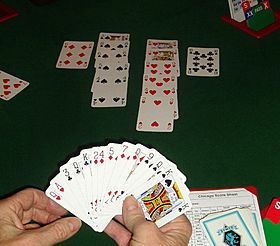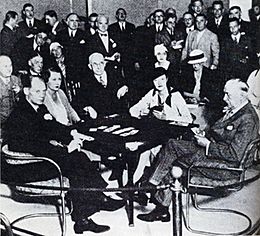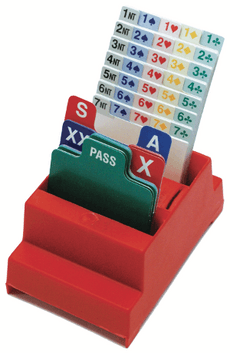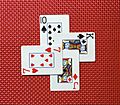Contract bridge facts for kids
Contract bridge, or simply bridge, is a trick-taking card game which is played by two pairs of players, one pair against the other pair. Partners sit opposite each other at a table.
Millions of people play bridge worldwide in clubs, tournaments, online and with friends at home. It is one of the world's most popular card games. The World Bridge Federation is the governing body for international competitive bridge.
The game consists of a number of "deals". Each deal goes through four phases: dealing the cards, the auction (also referred to as bidding), playing the cards, and scoring the results. Most club and tournament play uses duplicate bridge, where the cards are not re-dealt during a session. The same deals are played by most or all players. This allows comparative scoring.
Contents
History
Early history of bridge
It is played with the standard 52 cards in four suits. The game developed out of whist, which is a relatively old card game. Bridge developed in a series of stages from about 1890 to about 1930. The stages included bridge-whist and auction bridge, and the developments took place mostly in New York and London. The origin of the word "bridge" in this context is not really known. One possibility is that it is taken from an 1886 book, Biritch, or Russian Whist by John Collinson.
Playing method
Whist is played with the trump suit chosen by chance, whereas in bridge it is chosen by a process called "bidding". A trump is a card which can beat any card from the other three suits.
In whist, the winners had to get most of the tricks (a trick is a round of four cards), that is, seven or more tricks. However, in bridge the players bid in sequence to decide what the "contract" shall be. The contract is decided by the last bid, and will be in one of the four suits, or in "no trumps", without a trump suit.
The scoring rules and the bidding process evolved through stages between 1890 and about 1930. Bids at the one level are offers to make at least seven tricks. Bids at the seven level are offers to make all thirteen tricks. The lowest bid one can make is "one club" and the highest bid is "seven no trumps".
The scoring system for bridge is very much more complicated than it is for whist. Fundamentally, it depends on whether or not declarer makes his contract or not. If he does not, the defending side collect penalty points. If he does make the contract his side wins points. How many points are won or lost depends on the scoring system (not discussed here). Harold S. Vanderbilt played a key role in designing the scoring system, and in 1927 the Whist Club of New York produced a code for contract bridge. They and the Portland Club of London became the authorities who guided the later minor changes to the rules.
The set-up for playing the cards is also different from whist. The side which wins the bidding sequence plays with only one partner ("declarer") controlling both hands. His or her partner is called "dummy", and that hand is played face up on the table so all players can see it.
Duplicate bridge
Like much else in the game, the idea of duplicate play was invented for whist. At "whist drives" North/South pairs sat in the same positions throughout, East/West pairs moved up the series of tables and boards moved down. This simple movement was invented in the 19th century. The first game of duplicate whist was organised by "Cavendish" in London 1857, but it was not followed up. It was played in Chicago in 1880, and the first book about it was written in 1891 by John T. Mitchell. His simple method is known as the Mitchell movement.
Publicity in the 1930s
Contract bridge became one of the most popular pastimes when it was publicised by Ely Culbertson, a leading American player and organiser. Anglo-American matches got huge publicity in the newspapers, cinema and radio of the 1930s.
Example of a bidding sequence
| West | North | East | South |
|---|---|---|---|
| Pass | 1 Heart | Pass | 1 Spade |
| Pass | 2 Diamonds | Pass | 3 Spades |
| Pass | 4 Spades | Pass | Pass |
| Pass |
In the example on the right, West was the dealer and first to bid. The bidding goes as shown with South becoming the declarer in a 4 spades contract, he being the first to bid spades. East-West become the defenders and West becomes the opening leader, North becomes the dummy and spades the trump suit.
Ten tricks are required by North-South, six tricks plus the 4-level bid.
Mechanical dealing
Mostly, bridge is a social game played in clubs. A number of tables play the same set of hands, which allows for the scoring of individual pairs to be ranked. The deal is done by a computerised method. A pseudo-random algorithm sets the hands (the sets of cards held by each player). The computer is linked to a mechanical device which deals the cards and delivers them into the hands. These are put into the holding boards. The boards are then put on the tables.
Related pages
- American Contract Bridge League
- The Dutch Bridge Federation started in 1931.
Daniels, David 1980. The golden age of contract bridge. New York: Stein and Day. ISBN 0-8128-0-2576-4. Includes all stages from the history of whist to contract bridge, up to about 1950.
Images for kids
See also
 In Spanish: Bridge (juego) para niños
In Spanish: Bridge (juego) para niños









